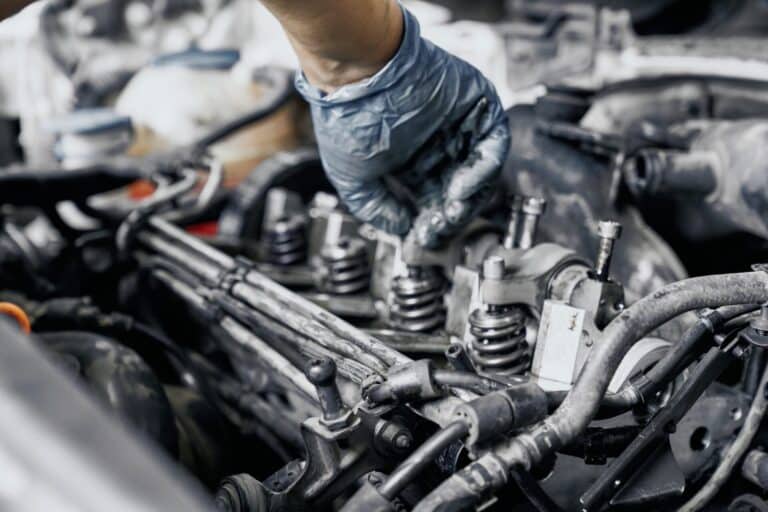Ram 1500 2/4 Drop On 24s (Beginners Guide)
Big wheels on trucks with lowered suspension give the Truck an attractive sporty appearance.
The lowered suspension also improves handling and truck speed.
Unfortunately, factors such as incorrect wheel size and unbalanced drop suspensions can lead to potentially dangerous issues like rubbing and misalignment while driving.
Therefore, knowing the right wheel sizes that best fit your vehicle’s lowered suspension levels is important for safe driving.
Let’s look at how 24-inch tires fit on a 2/4 drop suspension.
24-inch wheels fit comfortably within a 2/4 suspension drop, so long as the wheels have the correct offset and proportionate widths. However, it comes at the cost of reduced drive quality, constant scraping on fenders, and increased wear and tear on tires that potentially reduce the vehicle’s lifespan, making it a questionable investment for the long term.
What Is Wheel Size Best For 2/4 Suspension Drop?
Generally, 22-26 inch wheels work relatively well with the 2/4 suspension drop.
Because the stock height on many trucks is usually 2 inches higher in the rear end than the front end, whatever drop suspension gap you choose, it is best for your vehicle to always maintain the standard stock height difference.
In the 2/4 suspension drop, the Truck’s front end is lowered 2 inches, while the rear end is lowered 4 inches.
Other drop levels include 4/6, 2/2, 5/7, 2/2, etc.
However, when it comes to wheels, the size of the tires fitted on them is the major cause of rubbing in the Truck’s fenders.
Although wheel offset and width diameter also contribute. Each wheel size comes with its own recommended tire.
Usually, the Truck’s stock tires which fall under 275/60R20, can safely be used after a suspension drop.
Although, other tire sizes with unique variations in dimensions can also fit. 305/35-24 tires also work well with the 2/4 suspension drop.
The trick is to factor in the suspension gap when considering tire sizes for your wheel.
Regardless of the wheel and tire size, if the suspension drop is too close to the tires, there would be frequent rubbing and fender scraping, which would make for a very uncomfortable driving experience.
If your wheels have the right offset, there would be minimum clearance issues. 22-inch wheels are a much safer go-to option because they can fit bigger tires.
But, 24 and 26-inch wheels give the Truck a much better sporty look while also housing great tires.
Although fender scraping and rubbing are almost inevitable, in trucks with lowered suspensions, 22-inch wheels have a reduced chance of rubbing or at least won’t run as frequently as 24 or 26-inch wheels.
To get the best wheel sizes to match your Truck would involve considering tire size, wheel size, offset and drop suspension gap.
You could have slimmer tires on bigger wheels or bigger tires on smaller wheels.
Remember to always factor in drop suspension levels when choosing wheel sizes.
Benefits of Lowered Suspension
Ram lowering kits like ram lift kits and axle flip kits are used for suspension lifting and lowering.
Trucks are lowered differently than cars because of their different suspensions.
Therefore, for your Truck, the main focus is the level of drop Ram’s lowering kit can achieve.
Some suspension drop kits use drop coil springs because drop coil springs help to improve the responsiveness of the vehicle’s suspension and reduce body rollover.
Axle flip kits work by moving the rear axle of your Ram 1500 from underneath the leaf spring pack and putting it on top.
It generally gives your Truck about 6-8 inches of lowering gap.
On the other hand, Ram Lift kits create a gap between the vehicle’s body and the axles, creating added space between the Truck’s frame and the driving surface.
Therefore allowing bigger-sized tires and wheel combinations to be used. It is vital to consider shock absorbers for your Truck after lowering.
They provide a smoother driving experience after lowering.
Drop suspension increases your Truck’s center of gravity, giving it an aggressive stance and better stability while driving.
It enhances both physical appearance and driving performance.
The Truck’s closeness to the center of gravity allows for improved handling and maneuvering in sharper turns and general driving.
Although, this may not always be the case for all trucks after lowering.
The vehicle’s low height also means less air passes underneath the vehicle, reducing the drag imposed on the Truck and allowing the driver to enjoy faster acceleration and braking.
A cheaper alternative to suspension lowering that most cost-minded car owners use fixing lowering springs with the Truck’s stock shock absorbers.
Although lowering springs reduces the Truck’s ride height at a low cost, ride quality is seriously affected.
Disadvantages of lowered suspension
Despite the visual appeal, better handling, and faster acceleration lowered suspension gives, it comes with a few flaws that should be well noted.
A couple includes:
- Increased wear and tear
- Reduction in ride quality
- Low bottoms
- Rubbing
- Handling problems
Due to the Truck’s low height, driving through potholes and other road imperfections causes the wheels and tire components to slam hard at these surfaces leading to wear and tear on the wheels and other suspension components.
Slowly, the fasteners and bolts used to secure components loosen, causing rattling and creaking noises over time.
This action can reduce the lifespan of your Truck appreciably and make it feel older compared to other vehicles while driving it.
Wear and tear increases the cost of maintenance as regular changing of parts would be required, which would strain your budget.
Riding quality is significantly affected depending on how low the Truck is and the shock absorbers and drop coil springs used.
The Truck is more jiggly when driving through seemingly normal road bumps and potholes. That would not have been felt while using the Truck’s standard suspension.
The lowered suspension also causes scraping on the rear and front bumpers due to the Truck’s low suspension gap from the ground.
Scraping causes wear marks on the front and rear ends and can damage the Truck’s exhaust system.
The truck tires are also prone to rubbing while driving. The risk increases when the Truck goes over bumps or while turning.
This action wears the wheel and the tires out quickly and can lead to serious damage over time.
Lowered suspension trucks have great handling only when driven on impeccably smooth roads.
On rough roads, navigating the vehicle becomes extremely slow and much more difficult.
This problem is almost non-existent in standard suspension trucks.
Conclusion
In summary, 24 inches wheels fit well on trucks with 2/4 drop suspension.
Your choice of wheels should factor in the tire size and the suspension gap between the tire’s surface and the vehicle’s frame.
A suspension drop can make your Truck more aesthetically appealing, but costs to ride quality, rubbing, and handling may not be worth it.






